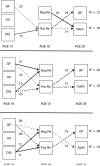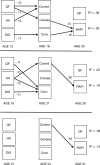Motives to drink or not to drink: longitudinal relations among personality, motives, and alcohol use across adolescence and early adulthood
- PMID: 23278843
- PMCID: PMC3620892
- DOI: 10.1111/acer.12030
Motives to drink or not to drink: longitudinal relations among personality, motives, and alcohol use across adolescence and early adulthood
Abstract
Background: Adolescent selective intervention programs for alcohol have focused on the identification of youth at risk as a function of personality and associated alcohol-related cognitions. Research into the role of personality, drinking motivations, and alcohol-related outcomes has generally focused exclusively on motives to drink. We expand on this literature by focusing on both motives to drink and motives not to drink across time from adolescence to early adulthood in a community sample.
Methods: Using 3 waves of data from 3 cohorts from the Rutgers Health and Human Development Project (n = 1,380; 49.4% women), we modeled the influence of baseline alcohol consumption, disinhibition (DIS), and harm avoidance (ages 15, 18, and 21 years) on drinking motives and motives not to drink 3 years later (ages 18, 21, and 24 years) and alcohol use and drinking-related problems 7 years subsequently (ages 25, 28, and 31 years).
Results: Path analytic models were relatively invariant across cohort. Across cohorts, DIS and baseline alcohol consumption related to later positive reinforcement drinking motives, but less consistency was found for the prediction of negative reinforcement motives to drink. While positive reinforcement motives were associated with greater alcohol consumption and problems 7 years later, negative reinforcement motives were generally associated with problems alone. Positive reinforcement motives for drinking mediated relations between baseline consumption and later consumption. However, results were mixed when considering DIS as a predictor and drinking problems as an outcome. Similarly, personality and baseline consumption related to later motives not to drink and such motives predicted subsequent alcohol-related problems. However, mediation was not generally supported for pathways through motives to abstain.
Conclusions: The results of this study replicate and extend previous longitudinal findings with youth and add to the growing literature on motivations not to engage in alcohol use.
Copyright © 2012 by the Research Society on Alcoholism.
Figures


Similar articles
-
To drink or not to drink: motives and expectancies for use and nonuse in adolescence.Addict Behav. 2011 Oct;36(10):972-9. doi: 10.1016/j.addbeh.2011.05.009. Epub 2011 May 30. Addict Behav. 2011. PMID: 21665373 Free PMC article.
-
I drink alone: Mechanisms of risk for alcohol problems in solitary drinkers.Addict Behav. 2020 Mar;102:106147. doi: 10.1016/j.addbeh.2019.106147. Epub 2019 Oct 15. Addict Behav. 2020. PMID: 31739083
-
Coping-motivated escalations in adolescent alcohol problems following early adversity.Psychol Addict Behav. 2023 Mar;37(2):331-340. doi: 10.1037/adb0000788. Epub 2021 Oct 7. Psychol Addict Behav. 2023. PMID: 34618492 Free PMC article.
-
Why do young people drink? A review of drinking motives.Clin Psychol Rev. 2005 Nov;25(7):841-61. doi: 10.1016/j.cpr.2005.06.002. Clin Psychol Rev. 2005. PMID: 16095785 Review.
-
Associations between solitary drinking and increased alcohol consumption, alcohol problems, and drinking to cope motives in adolescents and young adults: a systematic review and meta-analysis.Addiction. 2020 Nov;115(11):1989-2007. doi: 10.1111/add.15055. Epub 2020 Apr 27. Addiction. 2020. PMID: 32196794 Free PMC article.
Cited by
-
Clusters of alcohol abstainers and drinkers incorporating motives against drinking: a random survey of 18 to 30 year olds in four cities in four different continents.AIMS Public Health. 2019 Jan 17;6(1):15-33. doi: 10.3934/publichealth.2019.1.15. eCollection 2019. AIMS Public Health. 2019. PMID: 30931340 Free PMC article.
-
The direct effect of drinking to cope on alcohol problems is not mediated by alcohol consumption: Invariance across gender and countries.Addict Behav Rep. 2022 Nov 1;16:100469. doi: 10.1016/j.abrep.2022.100469. eCollection 2022 Dec. Addict Behav Rep. 2022. PMID: 36388406 Free PMC article.
-
The effect of impulsivity and drinking motives on alcohol outcomes in college students: a 3-year longitudinal analysis.J Am Coll Health. 2022 Aug-Sep;70(6):1624-1633. doi: 10.1080/07448481.2020.1817033. Epub 2020 Oct 13. J Am Coll Health. 2022. PMID: 33048641 Free PMC article.
-
Qualitative study of changes in alcohol use among HIV-infected adults entering care and treatment for HIV/AIDS in rural southwest Uganda.AIDS Behav. 2015 Apr;19(4):732-41. doi: 10.1007/s10461-014-0918-5. AIDS Behav. 2015. PMID: 25323678 Free PMC article.
-
Long-term chronicity of work addiction: the role of personality and work motivations.BMC Psychol. 2025 May 29;13(1):578. doi: 10.1186/s40359-025-02907-6. BMC Psychol. 2025. PMID: 40442758 Free PMC article.
References
-
- Bates ME, Labouvie EW. Adolescent risk factors and the prediction of persistent alcohol and drug use into adulthood. Alcohol Clin Exp Res. 1997;21:944–950. - PubMed
-
- Brown SA, Ramo DE, Anderson KG. Long-term trajectories of adolescent recovery. In: Kelly J, White W, editors. Addiction recovery management: theory, research and practice. Humana Press; Totowa: 2011. pp. 127–142.
Publication types
MeSH terms
Grants and funding
LinkOut - more resources
Full Text Sources
Medical

